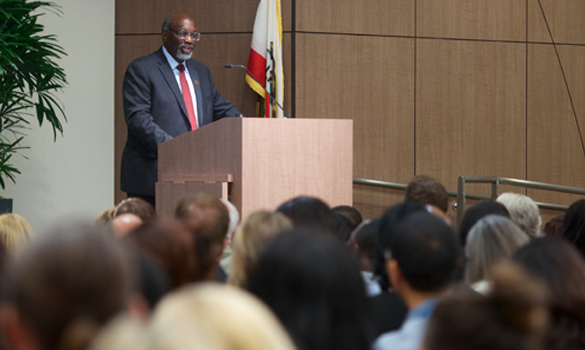On the 113th day of his permanent appointment by the California State University Board of Trustees as president of CSU Dominguez Hills, Willie J. Hagan welcomed faculty, staff–several of whom are recent additions–and students to the campus during the annual fall convocation.

The Sept. 12 event held in the Loker Student Union Ballroom drew a large crowd of approximately 400 people who were treated to details of the university’s history that Hagan said help to make its achievements particularly significant.
“California State University, Dominguez Hills has always been a catalyst for change, a place of individual and social transformation,” he remarked. “This is who we are. Despite the push and pull of politics, technology, and budgets, we need to remain true to our mission.”
In the same vein, Jerry Moore, professor of anthropology and chair of Academic Senate, touched on the history of the university as well, explaining, “Established in 1960 during California’s great expansion of higher education and placed on this campus in the aftermath of the 1965 conflicts of race and poverty that engulfed Watts and other regions, Cal State University, Dominguez Hills has a unique trajectory, which leads to this morning’s convocation. This university is built on a pivotal encounter… between three parties: the student, the teacher, and the world that student and teacher investigate together.”
The sentiments expressed by Hagan and Moore seemed to resonate with many faculty and staff members and served as a reminder that their efforts toward student achievement are effective contributions to the university’s mission to provide accessible and transformative educational opportunities.
“The point that the president made about the beginnings of the campus as a sociological experiment and then pointing out how extensive, and how impressive the statistics are today, was what struck me as heartening to hear,” said Gregory Williams, who is the director of Archives and Special Collections.
Hagan outlined some of the achievements made in the last year including being ranked sixth in the nation by Business Insider for accessibility, affordability, and outcome, and ranked eighth in the nation by Washington Monthly for serving the public good, using the criteria of upward mobility for low-income students, research and commitment to public service, as well as being recognized by the President’s Higher Education Community Service Honor Roll as one of the leading colleges in terms of community service.
The university continues a pattern of strong growth in enrollment, he said, with the largest first-time freshman and transfer student classes, at 1,552 and 2,665 respectively, factoring into what could be a record total enrollment of approximately 14,500 (Final enrollment numbers will be available after Census Day on Sept. 20). This year, he reported, graduate students increased by seven percent, reaching 1,136, and 850 aspiring educators enrolled in the university’s teaching credential programs. He also noted that since the implementation of several student success initiatives, student retention and performance have increased significantly. Hagan cited, for instance, a record 162 student athletes earned honor roll status in 2012-13.
He acknowledged the contributions made by faculty and staff toward student success, as well as those that resulted in well over $3.5 million in new annual and multi-year grant awards. There was also $600,000 allocated from the university’s budget to support faculty internal research, as well as the implementation of Information Technology’s computer and iPad upgrade rollout for faculty and staff over the next few years.
President of Associated Students, Incorporated, Gavin Centeno, a senior majoring in public administration, delivered a promise to serve with integrity as well as a message of appreciation to faculty and staff.
“Thank you so much for all the sacrifices you make for us,” he said on behalf of students. “It is everyday, in the interaction with our students, that [faculty and staff] keep striving for student success.”
To improve the occurrence of such encounters, Hagan referred to a multi-year plan to hire 50 tenure and tenure-track faculty members. Bringing applause from the audience, he expressed a desire to shift away from a “history of interim appointments,” to permanently fill senior administrative positions. Also, over the last year, 18 staff members were hired into new positions joining 1,300 campus workers.
He also pointed out that a plan is being developed for the “modest, but regular” budget increases that California’s governor, Jerry Brown, has pledged to allocate to the CSU over the next several years. Among the campus community and more than 80,000 alumni, Toros account for about $20 million in state tax revenues.
“I think you’ll have to agree that California State University, Dominguez Hills was an extraordinarily successful sociological experiment,” Hagan said.